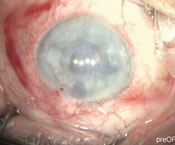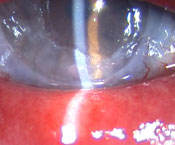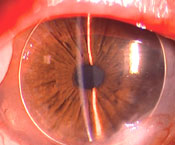Intrastromal corneal ring helps prevent graft rejection, study says
The metal components of the ring seem to have a significant impact on immune-competent cells.
![ESCRS Winter Refractive Surgery Meeting [logo]](/~/media/images/news/print/ocular-surgery-news-europe-asia-edition/2006/06_june/escrslogo_200_64_16867.jpg)
MONTE CARLO — The implantation of an intrastromal corneal ring in patients undergoing corneal transplant may reduce immune reaction, according to the developer of the device.
“We made and implanted these rings for years to reduce astigmatism, stabilize the wound and improve healing,” said Jörg H. Krumeich, MD, referring to intrastromal corneal rings (ISCR) of his own design, also known as Krumeich rings.
“Quite unexpectedly, however, we observed that for some reason these patients had less immune reaction. We investigated this aspect, and we confirmed that the [intrastromal corneal rings] possess immune-suppressing properties,” he said at the European Society of Cataract and Refractive Surgeons Winter Refractive Surgery Meeting.
The Krumeich ISCR is made from an alloy of 69% cobalt, 24% steel, 4.5% molybdenum and 2% titanium, according to Dr. Krumeich. It is produced and distributed by HumanOptics. The ring preferably should be used with the guided trephine system or the Hanna trephine, he said.
Barrier to immune reaction
In a study, 179 consecutive cases of penetrating keratoplasty with ISCR implants were compared with 101 eyes that had undergone the same procedure without the ring. The follow-up in all eyes was at least 4 years.
“In the eyes where the ring was implanted, the immune rejection rate was significantly lower (two cases out of 179, 1.2%) than in the control group (six cases out of 101, 6%). We also observed that the immune reaction in the eyes with the ring occurred within a few months after the operation, while the immune reaction without the ring had a tendency to occur also much later, up to 2 years postoperatively,” Dr. Krumeich said. He noted that 60% of the rejection cases with the ring could be resolved with the appropriate immunosuppressant therapy whereas only 14% of the rejection cases without the ring could be treated successfully.
This effect may be connected with the material from which the ring is made, Dr. Krumeich said. Preliminary investigations made in vitro by Prof. Uwe Pleyer, an ophthalmic immunology expert in Berlin, found that in MLC assay the release of IFN-gamma was significantly reduced by the use of the Krumeich ring as compared with controls, demonstrating that the metal components of the ring have a significant impact on immune-competent cells.
“We are only at the beginning of our investigation. We don’t know how this mechanism works, but there is definitely an influence on the secretion of these cells,” Dr. Krumeich said.
|
|
Images: Krumeich JH |
|
|
|
|
New vessel growth
Another question for Dr. Krumeich was whether his ring had the capability of inhibiting immune reaction in cases in which rejection had occurred at least twice.
“We had several successful cases of this sort. Two consecutive transplants without success, then a third transplant with the ring that works perfectly well and is still clear after 4 years,” Dr. Krumeich said.
In addition, the ring also appears to have inhibitory effects on vascular growth. Once the ISCR is implanted, superficial vessel growth may occur, but it almost invariably stops outside the ring and only in rare cases crosses over.
“Again we don’t know the reason, but the ring acts like a barrier against neovascularization,” Dr. Krumeich said.
“Once we know exactly what metal components are involved in this stoppage of the vessel growth and immune reaction, we could further improve the manufacturing and the performance of the ring,” he said.
For more information:
- Jörg H. Krumeich, MD, can be reached at Clinic Krumeich, Propst-Hellmich Promenade 28-30, Bochum D-44866, Germany; +49-2327-82002; fax: +49-2327-88171; e-mail: jk@krumeich.de. Dr. Krumeich has no direct financial interest in the products mentioned in this article, nor is he a paid consultant for any companies mentioned.
- HumanOptics AG, manufacturer of the Krumeich ISCR, can be reached at Spardorfer Str. 150, 91054 Erlangen, Germany; +49-9131-50665-0; fax: +49-9131-50665-90; e-mail: mail@humanoptics.com; Web site: www.humanoptics.com.
- Michela Cimberle is an OSN Correspondent based in Treviso, Italy, who covers all aspects of ophthalmology. She focuses geographically on Europe.







